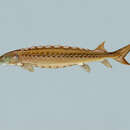en
names in breadcrumbs


Acipenser is a genus of sturgeons. With 17 living species (others are only known from fossil remains), it is the largest genus in the order Acipenseriformes. The genus is paraphyletic, containing all sturgeons that do not belong to Huso, Scaphirhynchus, or Pseudoscaphirhynchus, with many species more closely related to the other three genera than they are to other species of Acipenser. They are native to freshwater and estuarine systems of Eurasia and North America, and most species are threatened.[2] Several species also known to enter near-shore marine environments in the Atlantic, Arctic and Pacific oceans.
This is an ancient genus, with fossil species known as far back as the Late Cretaceous. In fact, the fossils of two species (A. praeparatorum and A. anisinferos) are known from mass mortality assemblages immediately following the Chicxulub impact, the beginning of the Cretaceous-Paleogene extinction event.[3]
There are 17 living species:[2]
There are 9 species known from fossil remains:[4]
Acipenser is a genus of sturgeons. With 17 living species (others are only known from fossil remains), it is the largest genus in the order Acipenseriformes. The genus is paraphyletic, containing all sturgeons that do not belong to Huso, Scaphirhynchus, or Pseudoscaphirhynchus, with many species more closely related to the other three genera than they are to other species of Acipenser. They are native to freshwater and estuarine systems of Eurasia and North America, and most species are threatened. Several species also known to enter near-shore marine environments in the Atlantic, Arctic and Pacific oceans.
This is an ancient genus, with fossil species known as far back as the Late Cretaceous. In fact, the fossils of two species (A. praeparatorum and A. anisinferos) are known from mass mortality assemblages immediately following the Chicxulub impact, the beginning of the Cretaceous-Paleogene extinction event.